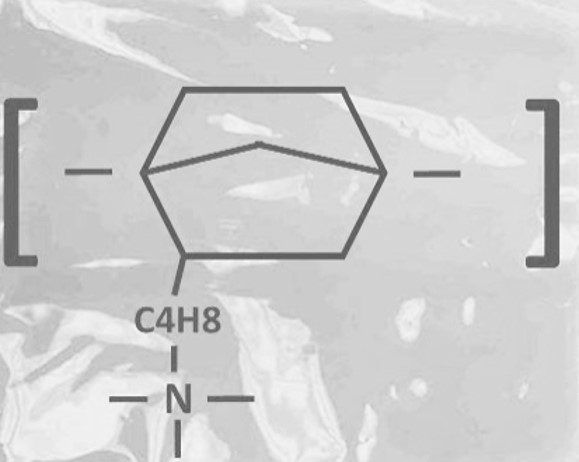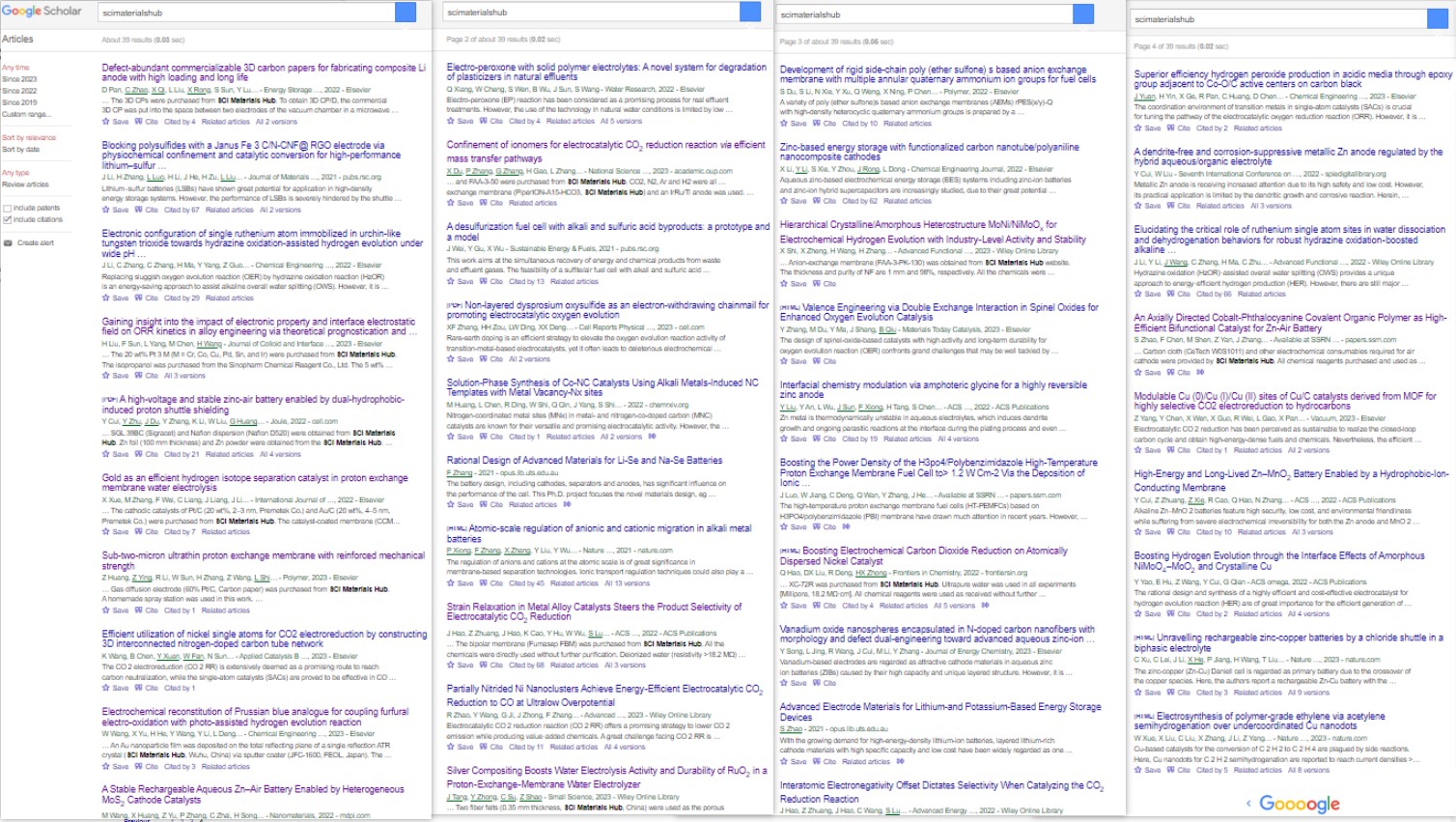
1. Introduction
Pention dispersions (also known as ionomers) are highly conductive and stable liquid solutions, and therefore useful for incorporation into electrode layers involving anion exchange membranes (AEM).
2. Applications
Pention dispersion products can be used in various electrochemical applications including fuel cells, electrolyzers, sensors, and flow batteries and other electrochemical applications/technologies. Membranes with Pention resin have demonstrated the highest recorded AEM fuel cell performance with a peak power density of 3.4 W/cm2 (jointly conducted study between NREL, University of South Carolina, and Georgia Institute of Technology).
3. Pention dispersions & solutions in SCI Materials Hub
| Model | Dispersion | Solution |
| D18-5wt% | Pention-D18-5wt% Dispersion | -- |
| D35-5wt% | Pention-D35-5wt% Dispersion | -- |
| D72-5wt% | Pention-D72-5wt% Dispersion | -- |
| S72-5wt% | -- | Pention-S72-5wt% Solution |
| S72-10wt% | -- | Pention-S72-10wt% Solution |
| S72-20wt% | -- | Pention-S72-20wt% Solution |
4. Features
The ionomer structure contains a poly(norbornene) backbone and is sold in either functionalized and non-functionalized forms. The functionalized polymer is sold as a dispersion for use in electrode layers and is functionalized with a quaternary ammonium group.
The functionalized polymer is not soluble in conventional solvent systems, so for membrane casting the unfunctionalized polymer is dissolved in solution and must be functionalized after membrane manufacture.
The unfunctionalized polymer is sold in the solution form. "D" in the product name stands for dispersion and "S" in the product name stands for solution. Dispersions are ionically conducting materials and ready to be used in the as received form. Solutions, on the other hand, are currently being supplied in the unfunctionalized form and the products made with the solutions needs to be functionalized in order to make them ionically conductive.
5. Chemical properties
Chemical composition of the quaternary ammonium modified poly(norbornene) polymer is provided below.

Pention-D72-5wt% is a quaternary ammonium functionalized dispersion with 5wt% polymer concentration in an organic solvent. This dispersion belongs to D72 series and it has an IEC (meq/g) of 3.45 to 3.55. Dispersion products are highly suitable for electrode manufacturing such as catalyzed gas diffusion layers and other similar products/components.
6. Physical properties
Hydrophilic order of Pention dispersions as follows: D72 series (the most hydrophilic) >> D35 series >> D18 series (the least hydrophilic).
Hydrophobic order of Pention dispersions as follows: D72 series (the least hydrophobic) << D35 series << D18 series (the most hydrophobic).
If maintaining the hydration or keeping the water is important for the intended application, then the most hydrophilic dispersion should be used. If removal of the by-product water is important for the intended application, then the intermediate or most hydrophobic dispersion should be used.
- Very high conductivity
- Great chemical stability
- Hydrophilic or hydrophobic natured depending on the selected series of the dispersion products
8. Welcome to cite our materials in your papers
Pention-D72-5wt%, a quaternary ammonium functionalized dispersion with 5wt% polymer concentration in an organic solvent, was obtained from SCI Materials Hub.
Please note that Xergy Pention dispersions contain solvents that may compromise the seals of the bottles if the solvents are left in direct contact with the lids for long periods of time. We recommend always storing the bottles in an upright orientation as soon as the shipment is received to lessen the likelihood of inadvertent leakage.
| Solvay Aquivion Dispersions | |
| Form | Liquid |
| Polymer Concentration | 5 wt% |
| Solvent System | Organic (undisclosed) |
| Total Acid Capacity | 3.45 to 3.55 meq/g (Internal Method) |
| HSE/Transport Classification | Corrosive/Hazardous |
Pention dispersions (also known as ionomers) are highly conductive and stable liquid solutions, and therefore useful for incorporation into electrode layers involving anion exchange membranes (AEM). The ionomer structure contains a poly(norbornene) backbone and is sold in either functionalized and non-functionalized forms. The functionalized polymer is sold as a dispersion for use in electrode layers (such as preparing the catalyst inks or slurries for fabrication of catalyzed gas diffusion layers or gas diffusion electrodes, GDEs, etc.) and is functionalized with a quaternary ammonium group. The functionalized polymer is not soluble in conventional solvent systems, so for membrane casting the unfunctionalized polymer is dissolved in an organic solution and must be functionalized after the membrane manufacturing step. The unfunctionalized polymer is sold in the solution form.
“D” in the product name stands for dispersion and “S” in the product name stands for solution. Dispersions are ionically conducting materials and ready to be used in the as received form. Solutions, on the other hand, are currently being supplied in the unfunctionalized form and the products made with the solutions needs to be functionalized in order to make them ionically conductive. Chemical composition of the quaternary ammonium modified poly(norbornene) polymer is provided on the right side.
Pention-D72-5wt% is a quaternary ammonium functionalized dispersion with 5wt% polymer concentration in an organic solvent. This dispersion belongs to D72 series and it has an IEC (meq/g) of 3.45 to 3.55. Dispersion products are highly suitable for electrode manufacturing such as catalyzed gas diffusion layers and other similar products/components.
Hydrophilic order of Pention dispersions as follows: D72 series (the most hydrophilic) >> D35 series >> D18 series (the least hydrophilic). Hydrophobic order of Pention dispersions as follows: D72 series (the least hydrophobic) << D35 series << D18 series (the most hydrophobic). If maintaining the hydration or keeping the water is important for the intended application, then the most hydrophilic dispersion should be used. If removal of the by-product water is important for the intended application, then the intermediate or most hydrophobic dispersion should be used.
Pention dispersion (also known as ionomers) products can be used in various electrochemical applications including fuel cells, electrolyzers, sensors, and flow batteries and various other electrochemical applications/technologies. Membranes made with Pention resin have demonstrated the highest recorded AEM fuel cell performance with a peak power density of 3.4 W/cm2 (jointly conducted study between NREL, University of South Carolina, and Georgia Institute of Technology). The stated electrochemical performance data is for reference only and depending on the MEA, CCM or GDE manufacturing method, used membrane thickness, testing hardware design and components used in the test hardware, and operational parameters (temperature, pressure, reactant flow rates, etc.), those values may or may not be attained.
Key Advantages of Pention Dispersions:
- Very high conductivity
- Great chemical stability
- Hydrophilic or hydrophobic natured depending on the selected series of the dispersion products
Pention dispersions are considered hazardous items under DOT and IATA regulation. 125 mL and 250 mL dispersions will incur a hazardous fee to accommodate the regulations based on the final shipping location (which is included in the pricing listed on the Fuel Cell Store product pages).
Please note that Xergy Pention dispersions contain solvents that may compromise the seals of the bottles if the solvents are left in direct contact with the lids for long periods of time. We recommend always storing the bottles in an upright orientation as soon as the shipment is received to lessen the likelihood of inadvertent leakage.
For international orders, please ask us for quotes via
Email: contact@scimaterials.cn
Tel: +86 130-0303-8751 / +86 156-0553-2352
Wechat: 15375698751
Volume (ml) | 5 | 25 |
Retail price (U.S. $) | Request | Request |
* Worldwide shipping via DHL, SF-Express & other requested carriers.
* Bulk quantities with discount upon request.
* Payments via Bank Transfer, Paypal, Credit card (via Taobao), Alipay, Wechat-pay are accepted.
Partial references citing our materials (from Google Scholar)

Carbon Dioxide Reduction
1. ACS Nano Strain Relaxation in Metal Alloy Catalysts Steers the Product Selectivity of Electrocatalytic CO2 Reduction
The bipolar membrane (Fumasep FBM) in this paper was purchased from SCI Materials Hub, which was used in rechargeable Zn-CO2 battery tests. The authors reported a strain relaxation strategy to determine lattice strains in bimetal MNi alloys (M = Pd, Ag, and Au) and realized an outstanding CO2-to-CO Faradaic efficiency of 96.6% with outstanding activity and durability toward a Zn-CO2 battery.
2. Front. Chem. Boosting Electrochemical Carbon Dioxide Reduction on Atomically Dispersed Nickel Catalyst
In this paper, Vulcan XC-72R was purchased from SCI Materials Hub. Vulcan XC 72R carbon is the most common catalyst support used in the anode and cathode electrodes of Polymer Electrolyte Membrane Fuel Cells (PEMFC), Direct Methanol Fuel Cells (DMFC), Alkaline Fuel Cells (AFC), Microbial Fuel Cells (MFC), Phosphoric Acid Fuel Cells (PAFC), and many more!
3. Adv. Mater. Partially Nitrided Ni Nanoclusters Achieve Energy-Efficient Electrocatalytic CO2 Reduction to CO at Ultralow Overpotential
An AEM membrane (Sustainion X37-50 Grade RT, purchased from SCI Materials Hub) was activated in 1 M KOH for 24 h, washed with ultra-purity water prior to use.
4. Adv. Funct. Mater. Nanoconfined Molecular Catalysts in Integrated Gas Diffusion Electrodes for High-Current-Density CO2 Electroreduction
In this paper (Supporting Information), an anion exchanged membrane (Fumasep FAB-PK-130 obtained from SCI Materials Hub (www.scimaterials.cn)) was used to separate the catholyte and anolyte chambers.
SCI Materials Hub: we also recommend our Fumasep FAB-PK-75 for the use in a flow cell.
5. Appl. Catal. B Efficient utilization of nickel single atoms for CO2 electroreduction by constructing 3D interconnected nitrogen-doped carbon tube network
In this paper, the Nafion 117 membrane was obtained from SCI Materials Hub.
In this paper, Proton exchange membrane (Nafion 117), Nafion D520, and Toray 060 carbon paper were purchased from SCI Materials Hub.
7. National Science Review Confinement of ionomer for electrocatalytic CO2 reduction reaction via efficient mass transfer pathways
An anion exchange membrane (PiperION-A15-HCO3) was obtained from SCI Materials Hub.
8. Catalysis Communications Facilitating CO2 electroreduction to C2H4 through facile regulating {100} & {111} grain boundary of Cu2O
Carbon paper (TGPH060), membrane solution (Nafion D520), and ionic membrane (Nafion N117) were obtained from Wuhu Eryi Material Technology Co., Ltd (a company under SCI Materials Hub).
Batteries
1. J. Mater. Chem. A Blocking polysulfides with a Janus Fe3C/N-CNF@RGO electrode via physiochemical confinement and catalytic conversion for high-performance lithium–sulfur batteries
Graphene oxide (GO) in this paper was obtained from SCI Materials Hub. The authors introduced a Janus Fe3C/N-CNF@RGO electrode consisting of 1D Fe3C decorated N-doped carbon nanofibers (Fe3C/N-CNFs) side and 2D reduced graphene oxide (RGO) side as the free-standing carrier of Li2S6 catholyte to improve the overall electrochemical performance of Li-S batteries.
This paper used more than 10 kinds of materials from SCI Materials Hub and the authors gave detailed properity comparsion.
The commercial IEMs of Fumasep FAB-PK-130 and Nafion N117 were obtained from SCI Materials Hub.
Gas diffusion layers of GDL340 (CeTech) and SGL39BC (Sigracet) and Nafion dispersion (Nafion D520) were obtained from SCI Materials Hub.
Zn foil (100 mm thickness) and Zn powder were obtained from the SCI Materials Hub.
Commercial 20% Pt/C, 40% Pt/C and IrO2 catalysts were also obtained from SCI Materials Hub.
3. Journal of Energy Chemistry Vanadium oxide nanospheres encapsulated in N-doped carbon nanofibers with morphology and defect dual-engineering toward advanced aqueous zinc-ion batteries
In this paper, carbon cloth (W0S1011) was obtained from SCI Materials Hub. The flexible carbon cloth matrix guaranteed the stabilization of the electrode and improved the conductivity of the cathode.
4. Energy Storage Materials Defect-abundant commercializable 3D carbon papers for fabricating composite Li anode with high loading and long life
The 3D carbon paper (TGPH060 raw paper) were purchased from SCI Materials Hub.
5. Nanomaterials A Stable Rechargeable Aqueous Zn–Air Battery Enabled by Heterogeneous MoS2 Cathode Catalysts
Nafion D520 (5 wt%), and carbon paper (GDL340) were received from SCI-Materials-Hub.
Carbon cloth (W0S1011) and other electrochemical consumables required for air cathode were provided by SCI Materials Hub.
Oxygen Reduction Reaction
1. J. Chem. Eng. Superior Efficiency Hydrogen Peroxide Production in Acidic Media through Epoxy Group Adjacent to Co-O/C Active Centers on Carbon Black
In this paper, Vulcan XC 72 carbon black, ion membrane (Nafion N115, 127 μL), Nafion solution (D520, 5 wt%), and carbon paper (AvCarb GDS 2230 and Spectracarb 2050A-1050) were purchased from SCI Materials Hub.
2. Journal of Colloid and Interface Science Gaining insight into the impact of electronic property and interface electrostatic field on ORR kinetics in alloy engineering via theoretical prognostication and experimental validation
The 20 wt% Pt3M (M = Cr, Co, Cu, Pd, Sn, and Ir) were purchased from SCI Materials Hub. This work places emphasis on the kinetics of the ORR concerning Pt3M (M = Cr, Co, Cu, Pd, Sn, and Ir) catalysts, and integrates theoretical prognostication and experimental validation to illuminate the fundamental principles of alloy engineering.
Water Electrolysis
1. International Journal of Hydrogen Energy Gold as an efficient hydrogen isotope separation catalyst in proton exchange membrane water electrolysis
The cathodic catalysts of Pt/C (20 wt%, 2–3 nm) and Au/C (20 wt%, 4–5 nm) were purchased from SCI Materials Hub.
2. Small Science Silver Compositing Boosts Water Electrolysis Activity and Durability of RuO2 in a Proton-Exchange-Membrane Water Electrolyzer
Two fiber felts (0.35 mm thickness, SCI Materials Hub) were used as the porous transport layers at both the cathode and the anode.
3. Advanced Functional Materials Hierarchical Crystalline/Amorphous Heterostructure MoNi/NiMoOx for Electrochemical Hydrogen Evolution with Industry-Level Activity and Stability
Anion-exchange membrane (FAA-3-PK-130) was obtained from SCI Materials Hub website.
Fuel Cells
1. Polymer Sub-two-micron ultrathin proton exchange membrane with reinforced mechanical strength
Gas diffusion electrode (60% Pt/C, Carbon paper) was purchased from SCI Materials Hub.
Characterization
1. Chemical Engineering Journal Electrochemical reconstitution of Prussian blue analogue for coupling furfural electro-oxidation with photo-assisted hydrogen evolution reaction
An Au nanoparticle film was deposited on the total reflecting plane of a single reflection ATR crystal (SCI Materials Hub, Wuhu, China) via sputter coater.

|
We Provide A Broad Range of Materials, Instruments & Solutions in Advanced Science and Technologies | About Us |



